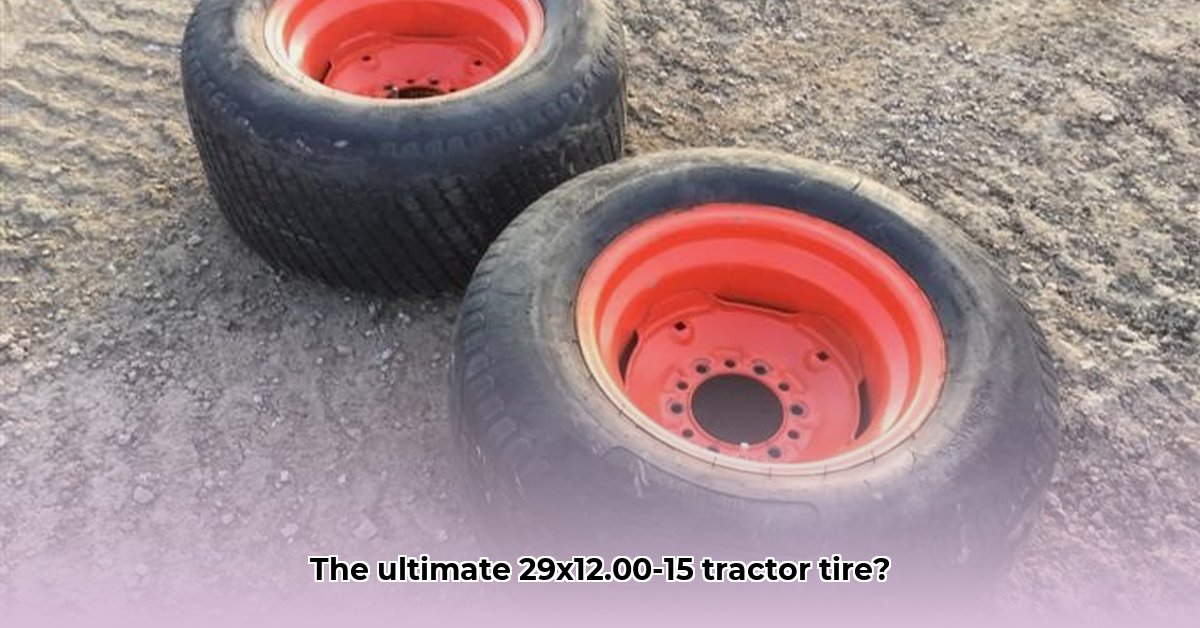
29x12.00-15 Tractor Tires: Choosing the Right Rubber
Selecting the ideal tire for your tractor demands careful consideration. The 29x12.00-15 size is prevalent, with the Carlisle Tru Power representing a popular choice. But is it the optimal solution for your specific needs? This analysis delves into the details to help you decide. Understanding tire specifications and market trends is crucial for maximizing operational efficiency and minimizing long-term expenses. What are the key factors influencing your tire selection? For more tire information, check out this helpful resource.
Bias-Ply Tires: A Traditional Approach
Bias-ply tires, the traditional design, feature layers running at an angle. This construction offers advantages such as lower initial cost and robust puncture resistance. However, compared to radial tires, they often exhibit less fuel efficiency, uneven wear, potentially reduced traction in certain conditions, and a shorter lifespan. Understanding these inherent trade-offs is critical before making a purchasing decision. Is the lower upfront cost of a bias-ply tire worth the potential long-term trade-offs?
Carlisle Tru Power 29x12.00-15: A Detailed Examination
The Carlisle Tru Power 29x12.00-15 bias-ply tire is widely available, frequently found through online retailers. However, a significant challenge lies in the limited availability of comprehensive technical specifications online. This information gap hinders direct comparisons with competing products and makes informed purchasing decisions difficult. Detailed specifications like load capacity and tread depth are crucial for performance evaluation. Why is readily accessible, detailed product information so vital for consumers?
The Competitive Landscape: 29x12.00-15 Tractor Tire Market
The online market showcases a diverse range of 29x12.00-15 tires from multiple manufacturers. This indicates substantial market demand, likely driven by the specific needs of various agricultural applications. But, the lack of standardized specification reporting across brands makes effective comparison and informed decision-making challenging. This underscores the need for improved product information transparency within the industry. How can manufacturers and retailers improve the transparency of product information for informed decision-making?
Actionable Insights for Key Stakeholders
The following table summarizes actionable insights for various stakeholders:
| Stakeholder | Key Takeaways |
|---|---|
| Carlisle (Manufacturer) | Enhance online product details with complete specifications; invest in R&D for specialized agricultural tasks. |
| Online Retailers | Improve product descriptions; incorporate comparison tools; showcase detailed technical specifications. |
| Tractor Owners | Conduct thorough research before purchasing; compare across brands based on detailed specifications. |
| Tire Recycling | Develop efficient and sustainable recycling processes for bias-ply tires. |
Risk Assessment and Challenges
Several factors pose potential challenges:
| Risk Factor | Likelihood | Impact | Mitigation Strategy |
|---|---|---|---|
| Insufficient Information | Very Likely | Significant | Demand comprehensive product details from manufacturers and retailers. |
| Intense Competition | Likely | Moderate | Focus on specific tire features (durability, cost) to differentiate offerings. |
| Evolving Consumer Needs | Moderately Likely | Significant | Monitor industry trends and customer reviews; anticipate future needs. |
| Environmental Concerns | Moderately Likely | Significant | Consider tire lifespan and recycling options; promote sustainable manufacturing practices. |
Regulatory Landscape and Future Outlook
Tire manufacturing is subject to stringent safety and quality regulations. Future environmental regulations may significantly impact the production costs and feasibility of bias-ply tires due to environmental concerns and waste generation. What is the impact of future environmental regulations on the production of bias-ply tires?
Comparing Bias and Radial Tires: A Comprehensive Guide
The Carlisle Tru Power is a bias-ply tire. However, radial tires represent a viable alternative. A direct comparison considering both short-term and long-term costs is crucial, as both tire types have unique advantages and disadvantages for the modern farmer. What factors should farmers consider when comparing bias and radial tires for their tractors?
Bias vs. Radial: A Detailed Comparison
| Feature | Bias-Ply Tires | Radial Tires |
|---|---|---|
| Initial Cost | Lower | Higher |
| Puncture Resistance | Higher | Lower |
| Fuel Efficiency | Lower | Higher |
| Tread Wear | Uneven, shorter lifespan | More even, longer lifespan |
| Soil Compaction | Greater | Less |
| Traction | Good on uneven terrain, less on firm surfaces | Excellent on firm surfaces, good on uneven terrain |
Step-by-Step Comparison Guide
Define Needs: Heavy tillage, light hauling, or frequent turns on uneven terrain will influence your choice.
Soil Conditions: Radials excel on firm ground; bias tires perform better on softer terrain.
Long-Term Costs: While bias tires have a lower upfront cost, radials offer long-term savings due to improved fuel economy and longer lifespan.
Sustainability: Radials minimize soil compaction, promoting sustainable farming practices.
Research Specific Models: Compare technical specifications (load capacity, speed ratings, tread patterns).
Seek Expert Advice: Your local agricultural equipment dealer can guide your decision.